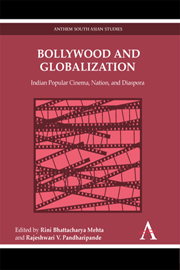Book contents
- Frontmatter
- Contents
- Acknowledgements
- Notes on Contributors
- Chapter One Bollywood, Nation, Globalization: An Incomplete Introduction
- Chapter Two Sentimental Symptoms: The Films of Karan Johar and Bombay Cinema
- Chapter Three Is Everybody Saying ‘Shava Shava’ to Bollywood Bhangra?
- Chapter Four Bollywood Babes: Body and Female Desire in the Bombay Films Since the Nineties and Darr, Mohra and Aitraaz: A Tropic Discourse
- Chapter Five Globalization and the Cultural Imaginary: Constructions of Subjectivity, Freedom & Enjoyment in Popular Indian Cinema
- Chapter Six Rang De Basanti: The Solvent Brown and Other Imperial Colors
- Chapter Seven Between Yaars: The Queering of Dosti in Contemporary Bollywood Films
- Chapter Eight Imagined Subjects: Law, Gender and Citizenship in Indian Cinema
- Chapter Nine ‘It's All About Loving Your Parents’: Liberalization, Hindutva and Bollywood's New Fathers
- Notes
- Select Bibliography
Chapter Two - Sentimental Symptoms: The Films of Karan Johar and Bombay Cinema
Published online by Cambridge University Press: 05 March 2012
- Frontmatter
- Contents
- Acknowledgements
- Notes on Contributors
- Chapter One Bollywood, Nation, Globalization: An Incomplete Introduction
- Chapter Two Sentimental Symptoms: The Films of Karan Johar and Bombay Cinema
- Chapter Three Is Everybody Saying ‘Shava Shava’ to Bollywood Bhangra?
- Chapter Four Bollywood Babes: Body and Female Desire in the Bombay Films Since the Nineties and Darr, Mohra and Aitraaz: A Tropic Discourse
- Chapter Five Globalization and the Cultural Imaginary: Constructions of Subjectivity, Freedom & Enjoyment in Popular Indian Cinema
- Chapter Six Rang De Basanti: The Solvent Brown and Other Imperial Colors
- Chapter Seven Between Yaars: The Queering of Dosti in Contemporary Bollywood Films
- Chapter Eight Imagined Subjects: Law, Gender and Citizenship in Indian Cinema
- Chapter Nine ‘It's All About Loving Your Parents’: Liberalization, Hindutva and Bollywood's New Fathers
- Notes
- Select Bibliography
Summary
Indian film historian Ashish Rajadhyaksha had once famously and perhaps apocryphally quipped that all Indian films may be divided into two categories – Bombay cinema and Satyajit Ray – the former a cinema for the masses, the latter an art cinema of limited commercial appeal of which Satyajit Ray was the great exemplar. More recently, this mass-class/commercial-art binary is being re-written by the popular press, and by fans and bloggers as ‘hat-ke’ versus ‘KJo.’ ‘Hat-ke’ literally means ‘off-center’ and ‘KJo’ is short for the Bollywood Director Karan Johar. These terms name divergent tendencies in Hindi cinema in the last decade and as such can shed light on the disintegration of film form and the segmentation of movie publics currently ongoing in the film industry. ‘Hat-ke’ refers to a growing body of films that are made on smaller budgets by new production corporations like Adlabs, Pritish Nandy Communications and UTVfilms. They feature lesser-known stars and match formal innovation with utterly contemporary – often risky – subject matter. The ‘hat-ke’ film usually plays well in the multiplexes in India's many urban centers and is favored by a younger, cosmopolitan spectator. Though more commercially oriented than art cinema, ‘hat-ke’ films share the vision of the art film movement that attempted to capture reality more authentically by creating an alternative to the mass product emanating from the industry in Bombay. In other words, they bear a morphologic affinity with what Rajadhyaksha calls the ‘Ray’ film.
- Type
- Chapter
- Information
- Bollywood and GlobalizationIndian Popular Cinema, Nation, and Diaspora, pp. 15 - 34Publisher: Anthem PressPrint publication year: 2010
- 9
- Cited by

